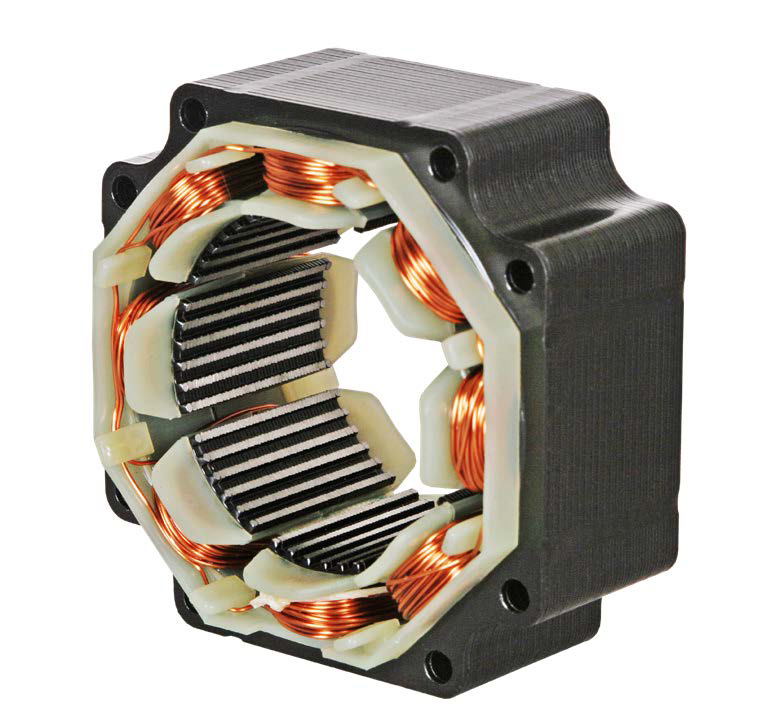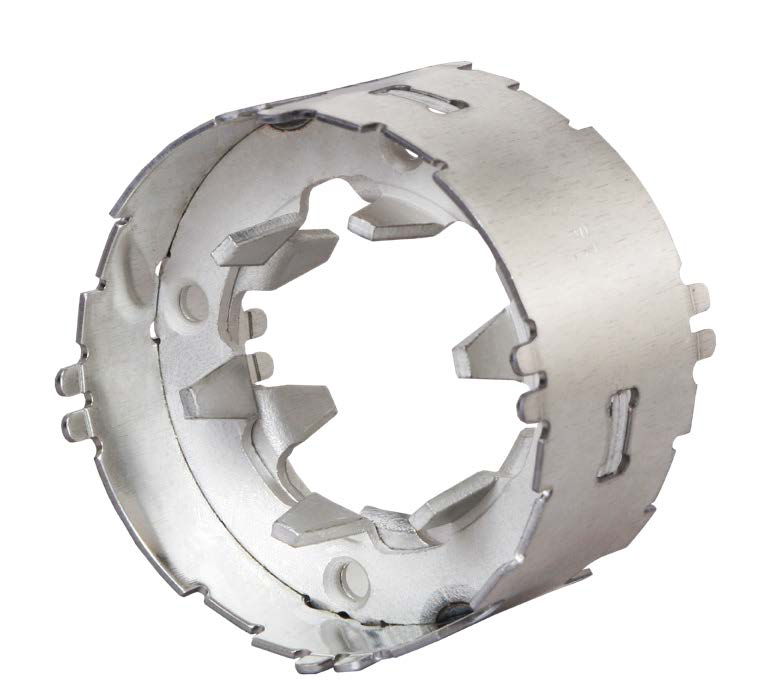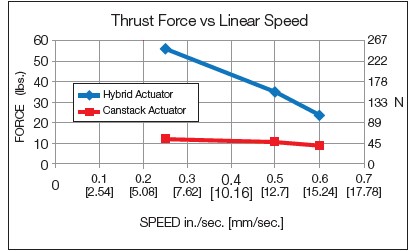This white paper will discuss why a size 17 Hybrid Linear Motor Actuator with an input wattage rating of 7 watts has better performance than a Can Stack Motor Actuator with an input rating of 10 watts.
The answer is the efficiency of the motor itself. The average Hybrid Motor Actuator is about 65% efficient while a Can Stack Motor Actuator averages 25% efficiency. There are 2 primary reasons for these differences in efficiency.
 Reason #1
Reason #1
The first reason is the use of a laminated Silicon steel stator assembly in the hybrid motor, see Figure 1, compared to a stamped low carbon steel field ring assembly in the Can Stack Motor, see Figure 2. The use of a laminated stator stack in the hybrid motor construction results in less eddy current loss and the Silicon steel material used in the lamination construction reduces hysteresis loss. Therefore the total iron loss in the hybrid motor is less than the Can Stack Motor resulting in the hybrid motor’s higher efficiency, series, 1.8 degree/step and .9 degree/step (versus 7.5 or 15 degrees for the typical Can Stack) will allow resolutions down to .000060 in.[0.001524 mm]/full step compared to .00025 in.[0.00635 mm]/full step in a Can Stack Motor. Therefore the hybrid motor provides much finer positioning capability.
 Reason #2
Reason #2
The second advantage is within the motor’s magnetic circuit. The construction of a hybrid motor actuator allows for the air gap between the rotor and stator assembly to be about ½ of what the Can Stack Motor actuator can be manufactured to. The air gap in the hybrid design is typically 0.003 to 0.004 inch [0.0762 to 0.1016 mm] compared to 0.007 to 0.008 inch [0.1778 to 0.2032 mm] in the Can Stack construction. The smaller air gap provides a more efficient magnetic coupling between the rotor and stator resulting in higher torque. See Figures 3 and 4.
 |
Figure 1: Laminated Steel Stator Assembly.
|
| |
 |
| Figure 2: Stamped Low Carbon Steel Field Ring. |
| |
| |
 |
| Figure 3: Air gap comparison Can Stack versus hybrid linear actuators. |
| |
| |
 |
| Figure 4: Effect of air gap on motor efficiency and performance. |
Comparing the size 17 single stack hybrid actuator (1.7 in.2 [43 mm2]) and the 46000 Can Stack Actuator (Ø1.8 in. [Ø 46 mm]), 7 watts and 10 watts of input power respectively, with the identical lead screw; the resulting force at the same linear velocity is much higher in the hybrid version, see Figure 5.
 |
| Figure 5: Air gap comparison Can Stack versus hybrid linear actuators |
 In addition to the efficiency advantages shown above there are other advantages that the hybrid actuators have over Can-Stack versions:
In addition to the efficiency advantages shown above there are other advantages that the hybrid actuators have over Can-Stack versions:
1. Stepper motor based linear actuators are extremely useful in positioning applications, whereas linear motion occurs for every pulse sent to the motor’s controller. The resolution of this motion is a function of the lead of the screw and the degrees per step of the stepper motor. The step angles available in the hybrid series, 1.8 degree/step and .9 degree/ step (versus 7.5 or 15 degrees for the typical Can Stack) will allow resolutions down to .000060 in.[0.001524 mm]/full step compared to .00025 in.[0.00635 mm]/full step in a Can Stack Motor. Therefore, the
hybrid motor provides much finer positioning capability.
2. Mounting of the actuator can play a critical role in overall system performance in many applications. The hybrid actuators have a locating boss on the front end bell which is concentric to the motor bearings allowing better mounting to center the actuator in the assembly. See Figure 6.
 |
| Figure 6: Locating boss feature for concentric mounting. |
As described, the hybrid stepper motor’s higher efficiency due to lower iron loss and smaller rotor to stator air gap, offers a higher output power density when compared to the Can Stack Motor. These features do come at an increased cost, if the Can Stack Actuators meet the required force, speed and resolution requirements it will be a less expensive solution.
In conclusion, if your application requires excellent repeatability, fine resolution capability, moderate to high-speed performance and specialized design modifications in a compact efficient package, a Haydon Kerk Motion Control hybrid actuator product line can provide an ideal solution for your design requirements.
Click here to download PDF version.